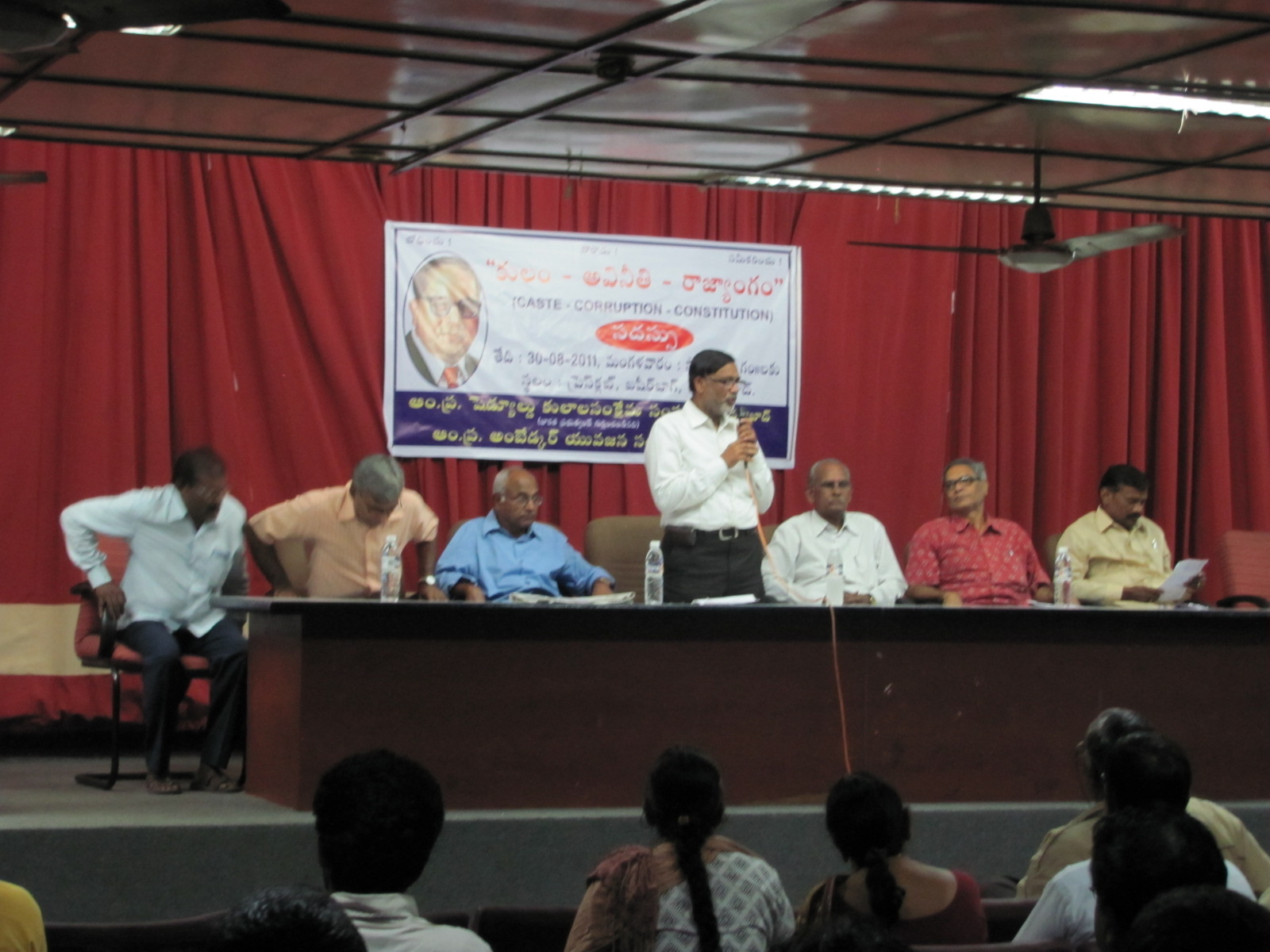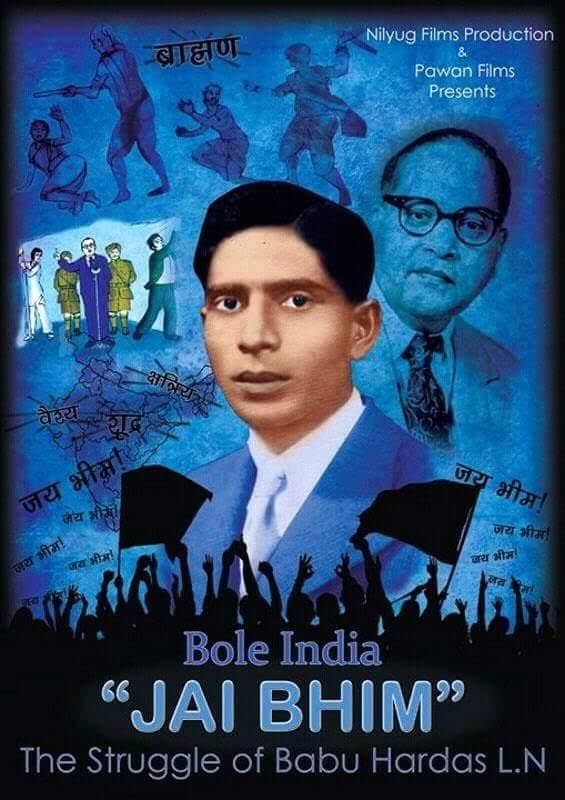Kuffir
(Excerpts from his speech at the ‘The Colonization of Ambedkar: Caste Politics behind Roy-Navayana’s Appropriation of Annihilation of Caste ~ A Discussion‘ held on 21st December, 2014, at University of Mumbai)
Thank you, I will be brief, Jai Bhim to all.

Some of you may be wondering what is this about? Many people, led by ‘educated’ people, in universities have said earlier, it is just words (Roy-Navayana’s attempt to appropriate Babasaheb’s AoC), it is just writing. How does it affect people on the ground? How does it affect the grassroots? Like we are not grassroots. We are from the grassroots! How does it affect the grassroots, say those who are evicted from slums in Mumbai or Bangalore or wherever. Those who have to fight for land rights in Chhattiisgarh or Telangana or wherever. What does it have to do with these people?
So, I will quote A. Roy’s own words to tell you what it has to do with these people. This is from a Feb 2001 interview with David Barsamian which appeared in The Progressive, an Ultra Left publication, an international website or magazine. Please note the interview itself is titled as Colonization of Knowledge, so we are not the first ones to speak about colonization of Ambedkar or knowledge, she was the one who started it way back in 2001. I quote from the interview:
The power of the World Bank is not only its money, but its ability to accumulate and manipulate knowledge. It probably employs more PhDs than any university in the world. It funds studies that suit its purpose. Then it disseminates them and produces a particular kind of world view that is supposedly based on neutral facts. But it’s not. It’s not at all. How do you deal with that?
This has to be understood in that sense. She is quite aware of what colonization of knowledge is. It is not like she suddenly wakes up, and after doing such a good deed of working two whole years reading Ambedkar, ‘taking the trouble of reading Ambedkar’, writes an introduction and doesn’t understand our objections about colonization of knowledge. It is not that she doesn’t know what colonization of knowledge means. What she says here, she talks about the World Bank; WB does not merely give out loans, it also controls governments, it controls policy, especially policy which effects the poor masses everywhere, in Latin America, Africa, South Asia, in America also. She says, “The power of the WB is not only its money but its ability to accumulate and manipulate knowledge.”
So this is about knowledge which is produced, mediated by a certain kind of worldview which is supposed to favour some sections of people and go against certain other sections of people. Control of knowledge is very important. If control of knowledge was not important, Ambedkar would not have said Educate (from his advice: Educate, Agitate, Organize), the first point is to Educate. And this is what the Roy-Navayana project is attempting to do: control Dalitbahujan knowledge, to mediate it, to manipulate it.
The whole history of the Shudras is about how, unlike even the Jews, they were always deprived of the Power of the Word. Every generation had to learn anew what it was to be a Shudra or Atishudra. Because knowledge was not passed on through books or [written] words from generation to generation. It could only be passed on through songs and other forms of theatre which is seen mostly as entertainment many a time and not as knowledge itself. Because it does not carry the ‘weight’, the ‘wisdom’ which is produced by people who are actually not engaged in any sector of production. Their knowledge is disentangled from labour and production, it is about control and manipulation.
When you come to Mumbai by plane or train, you first see the buildings, you see the sea and then you see the slums. 60% of all major cities- Delhi to Bangalore to Hyderabad to Kolkata to Mumbai is mostly slums. Once I looked up – what is the area of Mumbai city? Mumbai is around 1 lakh 60,000 acres. Out of which for 30 to 40 years, 30% of this land was locked up in urban ceiling litigation. The Govt did not employ the army to grab the land from the rich and distribute it among the poor. 30% of all land in Mumbai was owned by 20 or 30 families and it was allowed to lay idle. Thus it stayed in litigation for 30-40 years. Mane Sir knows a lot of about this. Now it has been released, and the population has increased so much, the people still don’t get a piece of it. How did all this manipulation of resources happen?
Dharavi, the biggest slum, is around 500 acres. Half a million to a million people live there. The rest of the population of Mumbai – around 60%, including the people of Dharavi, occupy another, let’s say, 10,000 acres. The remaining 1 lakh 50,000 acres is mostly occupied by the other 40% of the population, which is mostly Savarnas. If you do a real ethnographic study of Mumbai city, you will find that 90% of them (of the 40%) are Savarnas. And among the 90%, you will find that 30% are Brahmin. So this is as real as the ground under your feet. How did all this manipulation of resources happen?
The Brahminical knowledge hegemony works in the same way as the World Bank’s research hegemony: it uses the control of knowledge to control resources. The word is as real as the ground under your feet. You have to control or speak your own words. You have to speak in your own voice. You have to listen to your mind and conscience first before you start letting A. Roy tell you what caste is about. Until four years ago, from what Anoop shared, she did not know who Ambedkar was. She knew nothing about Ambedkar. This publisher, because he was looking for a marketable commodity, he went and dragged in this poor person. I have great sympathy for her and admire her as a writer. But her politics have always been regressive in many senses. So this is what this appropriation is about.
When you are deprived of the power of the word, your space shrinks down to merely 5% to 6% of what you deserve. If you are 60% of the population and you get only 5% of the space, literal space, in the city you live in, and you are further marginalized in the space of knowledge also, there is no way you can claim your rights. The evictions and appropriations are connected in very real terms.
That is why our objections to the Roy-Navayana project raise so many hackles across the Brahminical world: in academia, media and ‘civil society’. Why are the academics from Savarna castes and Brahmins so very keen on calling our critique as ‘reductive crap’? Why can’t they say, okay these guys are producing their own book, a compilation of critiques of the Roy-Navayana project, and that is a democratic thing? Why can’t they stop there? Because they are inherently incapable of recognizing anyone else’s rights. Because our critique is, from a larger perspective, a critique of the whole Brahminical hegemony over knowledge, over our universities, media, civil society. Because it affects their class interests.
As my favorite poet Sivasagar (KG Satyamurthy) says, I am the soldier and I am the battlefield too. So everyone is a soldier and the battlefield too. You have to fight for your own mind, for your own voice. You say, ‘Arundhati Roy has written, let her write. What is your problem?’ If Arundhati Roy has written, in a scenario where 98% of faculty in central universities are Savarna-Brahmin – who are the faculty going to teach and read in the classroom? Ambedkar or Arundhati Roy? They will segregate the original AoC from that book. It will be purely Arundhati Roy, portrayed as being in the forefront in the struggle against caste, which Ambedkar had actually waged, which Phule had waged, Nanak had waged, Kabir had waged, which Buddha had started, which the Charvakas had inspired..
As Anoop pointed out with so many examples, and as James has pointed out – about recent history from the colonial time wherein Phule’s and Ambedkar’s egalitarian, anti-caste politics were sidelined. So this is not about mere words. 98% savarna faculty reign in central universities – they have never called us for a debate on this subject. It is students from Mumbai university, a state university, who have called us. Central universities are ultra pure. Students here have organized this event on their own, we don’t know how they have done it, we had nothing to support them. They added our name Round Table India, out of their goodness of heart and broad-mindedness. It is they who have conducted the whole event, Suresh Mane Sir who gave the inspiration, the patronage to say, please come over, this is also our space. We don’t know how much of this is our space, 5% or 10%. For this day, this is our Dharavi.
So this is not just about A Roy. There are better writers than A Roy… why A Roy? Because she has perfected the art of being the casteless Indian just like Gandhi and Nehru. Nehru writes in his own autobiography, he starts with his ancestors’ ‘descent’. Like they descended from the Himalayas as gods, like Shivji came down from the Himalayas. Are these Gods? A Roy has perfected this tantalizing state of being casteless. Is this state of castelessness something that’s outside Indian polity, outside Indian society – this state of castelessness? Like the yogis and munis who go do penance and go into trances? Is this something like that? How can you be casteless?
Caste is the mode of production in India. This is a caste economy. This is a caste society. 90% of Bahujan are even now engaged in under-capitalized, traditional occupations. That is how your food is produced, your sarees and shirts and everything else is produced. Your jewelry is produced by artisans who are dying. Your fish, whatever fancy names you give and order in posh hotels paying 2000 Rs for two pieces, is produced by fishermen who are dying, who are being driven out of their homes. This is connected with that.
The first mistake the Bahujan did, one could say the original sin of the Bahujan world, was to allow the Brahmin to enter into their little shrines – to control the worship of their holy stones, trees, serpents, whatever they considered sacred. They invited the Brahmin to come in with his mumbo jumbo. They allowed the Brahmin to introduce their gods to themselves. It started there. We can’t allow that to happen again.
Please read about all other articles (with links) on the subject here.
~~~










